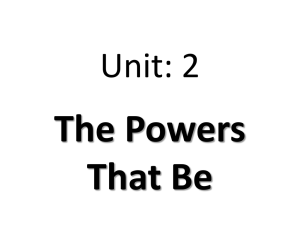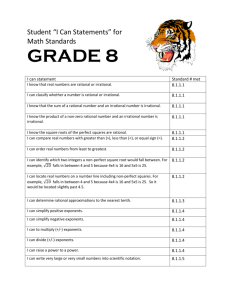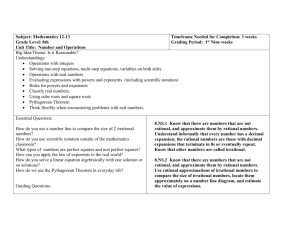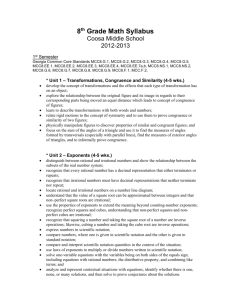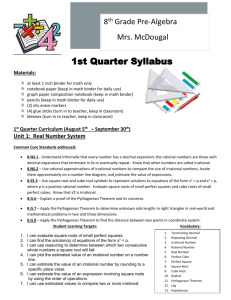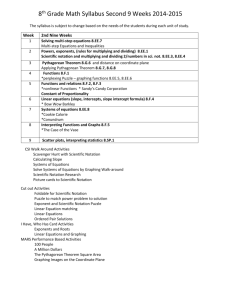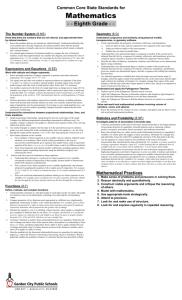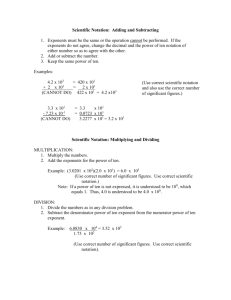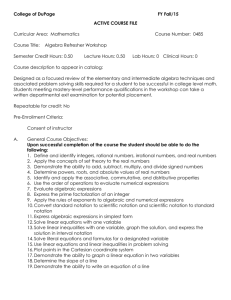8th Grade Pre-Algebra Mrs. McDougal 2ND Quarter Syllabus 2nd
advertisement
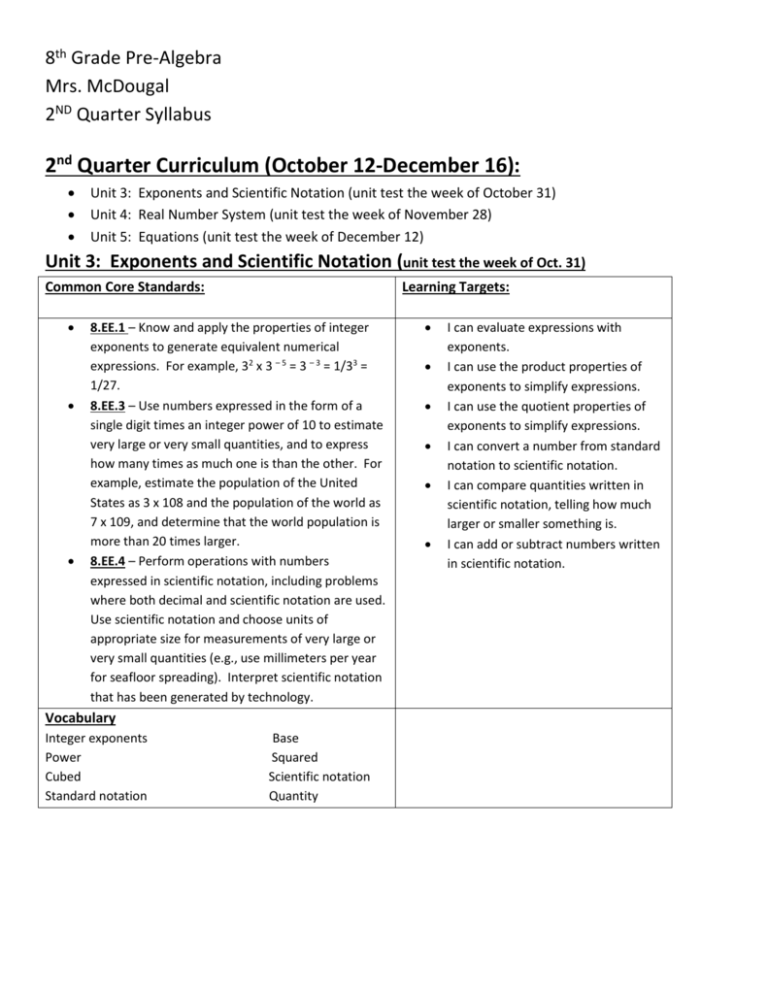
8th Grade Pre-Algebra Mrs. McDougal 2ND Quarter Syllabus 2nd Quarter Curriculum (October 12-December 16): Unit 3: Exponents and Scientific Notation (unit test the week of October 31) Unit 4: Real Number System (unit test the week of November 28) Unit 5: Equations (unit test the week of December 12) Unit 3: Exponents and Scientific Notation (unit test the week of Oct. 31) Common Core Standards: Learning Targets: 8.EE.1 – Know and apply the properties of integer exponents to generate equivalent numerical expressions. For example, 32 x 3 – 5 = 3 – 3 = 1/33 = 1/27. 8.EE.3 – Use numbers expressed in the form of a single digit times an integer power of 10 to estimate very large or very small quantities, and to express how many times as much one is than the other. For example, estimate the population of the United States as 3 x 108 and the population of the world as 7 x 109, and determine that the world population is more than 20 times larger. 8.EE.4 – Perform operations with numbers expressed in scientific notation, including problems where both decimal and scientific notation are used. Use scientific notation and choose units of appropriate size for measurements of very large or very small quantities (e.g., use millimeters per year for seafloor spreading). Interpret scientific notation that has been generated by technology. Vocabulary Integer exponents Power Cubed Standard notation Base Squared Scientific notation Quantity I can evaluate expressions with exponents. I can use the product properties of exponents to simplify expressions. I can use the quotient properties of exponents to simplify expressions. I can convert a number from standard notation to scientific notation. I can compare quantities written in scientific notation, telling how much larger or smaller something is. I can add or subtract numbers written in scientific notation. Unit 4: Real Number System (unit test the week of November 28) Common Core Standards: Student Learning Targets: 8.NS.1-Understand informally that every number has decimal expansion; the rational numbers are those with decimal expansions that terminate in 0s or eventually repeat. Know that other numbers are called irrational. 8.NS.2-Use rational approximations of irrational numbers to compare the size of irrational numbers, locate them approximately on a number line diagram, and estimate the value of expressions. 8.EE.2-Use square root and cube root symbols to represent solutions to equations of the form x2 = p and x3 = p, where p is a positive rational number. Evaluate square roots of small perfect squares and cube roots of small perfect cubes. Know that √2 is irrational. 8.G.6- Explain a proof of the Pythagorean Theorem and its converse. 8.G.7-Apply the Pythagorean Theorem to determine unknown side lengths in right triangles in real-world and mathematical problems in two and three dimensions. 8.G.8-Apply the Pythagorean Theorem to find the distance between two points in coordinate system. Vocabulary: Perfect square Cube root Rational number Pythagorean Theorem Square root Irrational number Real number Leg /hypotenuse I can identify a rational number and an irrational number. I can change a fraction to a decimal or a decimal to a fraction. I can identify a repeating decimal and a terminating decimal. I can approximate irrational numbers as rational numbers. I can approximately locate an irrational number on a number line. I can estimate the value of expressions involving irrational numbers. I can explain why the square root of 2 is irrational. I can calculate the solution(s) of equations of the form x2=p. I can calculate the solution of equations of the form x3=p I can evaluate square roots of small perfect squares. I can evaluate cube roots of small perfect cubes. I can explain a proof of the Pythagorean Theorem. I can calculate missing side lengths in real world problems using the Pythagorean Theorem. I can calculate the distance between two points in a coordinate system using the Pythagorean Theorem. Unit 5: Equations (unit test the week of December 12) Common Core Standards: Student Learning Targets: 8.EE.7a- Solve linear equations in one variable. Give examples of linear equations in one variable with one solution, infinitely many solutions, or no solutions. Show which of these possibilities is the case by successfully transforming the given equation into simpler forms, until an equivalent equation of the form s=a, a=a, or a=b results (where a and b are different number). 8.EE.7b- Solve linear equations with rational number coefficients, including equations whose solutions require expanding expressions using the distributive property and collecting like terms. Vocabulary: Linear equation Coefficient Distributive property Associative property I can identify and use the commutative, associative, and distributive properties. I can give examples of linear equations that have one solution, infinitely many solutions, and no solution. I can write and solve one-step linear equations. I can write and solve two-step linear equations containing rational number coefficients. I can solve multi-step linear equations containing rational number coefficients that require the use of the distributive property and combining like terms. Infinite solutions Like terms Commutative property Grading Policy: Target practice (Homework) will be assigned on a daily basis. Students are expected to complete all assignments and keep all notes, class activities, target practices, etc. in the one inch binder each quarter, along with their textbook for that particular unit. Notes/activities - Students are expected to take classroom lesson notes and complete all in-class activities. These will be kept in your binder to use for homework help and as study guides for quizzes and tests. Quizzes – These will range from 30 to 50 points and will be given over multiple lessons in a unit. Tests/Open Response Questions – These will be at the end of each unit and will be worth approximately 100 points each. Bellringers/Flashbacks – This is completed at the beginning of class each day. This task is worth 10 points weekly. Quarter Final – This will be a cumulative test given at the end of each quarter. Grading Percentages: 60% - Assessments/Tests 20% - Quarter Final 10% - Quizzes 10% - Engagement Credit (Classwork, Bellringers, Etc.) *The grades for tests, quizzes, bellringers, etc. will be entered into Infinite Campus within 5 days of the due date. *Students are expected to complete all assignments, even if you are absent. If a student has a missing assignment due to absences, then I will speak to him/her individually about a due date for those assignments. Quizzes and tests must be taken afterschool if an absence occurred on the day they were given. If you have any questions or concerns, please feel free to contact me by e-mail at patty.mcdougal@bgreen.kyschools.us or by phone at 746-2290. I will return emails and phone calls by 3:30 that day.

